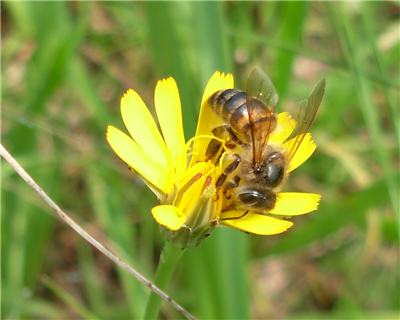In 2012, ProFound together with the Ethiopian Apiculture Board, SNV Ethiopia and Enclude (formerly Triodos-Facet) initiated the Apiculture Scaling-up Programme ASPIRE.
ASPIRE aims to enhance rural incomes in Ethiopia through beekeeping activities and increase the export volumes of bee products, including honey and other value added apiculture products such as beeswax, propolis, pollen, royal jelly and bee venom.
Beekeeping is a traditional off-farm activity for an estimated 1.4 million rural households in Ethiopia, earning them a third of their total household income. The country is the world’s 10th biggest honey producer and the 4th largest beeswax producer.
The beekeeping sector in Ethiopia
At present, the EU imports only 0.1% of its honey from Ethiopia. However, the demand for Ethiopian honey is growing continuously, due to the increased interest in alternative sources of good quality honey. In 2012, main EU importers of Ethiopian honey were Norway, the UK and Germany. The Middle East and the domestic market in particular are interesting markets for Ethiopian honey.
However, despite its long history, beekeeping in Ethiopia has not yet reached its full potential. The knowledge and skills of Ethiopian farmers in honey production and beeswax extraction have remained relatively traditional and inefficient. The country produces 40,000 tons of honey and 400 tons of beeswax annually, but it could produce up to 500,000 tons of honey and 50,000 tons of beeswax per year. However, in order to realise such production quantities, further upgrading and up-scaling of the existing value chains is required.
ASPIRE is using the value chain approach in order to achieve such objectives. The value chain approach looks at the entire chain of actors who add value to a product, from the raw material supplier to the final end user. It recognises the interdependence between the different value chain actors. The main goal of the value chain model is to deliver maximum value for the least possible total cost. Figure 1 on the next page provides information on the ASPIRE value chain approach to:
-
- Better organise beekeepers
-
- Facilitate access to business development services
-
- Ensure access to capital
-
- Ensure access to markets
-
- Build capacities of sector organisations
-
- Build knowledge in the honey value chain.

ProFound’s focus of activities and interventions is on processors, as they have the most power to influence other actors in the Ethiopian part of the value chain. As can be seen from the figure above, the processors are placed in the centre of the value chain as they are key to beekeepers, input suppliers, and consumers in the local market or abroad.
ProFound’s approach in facilitating market access for these processors/exporters encompasses four steps, which are explained below.
Step 1: Market analysis and company audits
Market analysis
According to our value chain approach, market needs and requirements must be identified through market research in order to determine which interventions are needed in the value chain. Initially, ProFound made an analysis of the European honey market which was distributed to all relevant stakeholders in the programme, including companies, sector organisations and programme partners. The market analysis confirmed the European market potential for Ethiopian honey, but also showed that compliance with European market requirements needs considerable upgrading of human, technological and financial business capacities.
Additionally, ProFound conducted a market analysis of the Ethiopian market for bee products. This research showed that the local market also offers plenty of opportunities, and that market requirements are less demanding than in Europe, making the Ethiopian market accessible to processors with moderate business capacities.
Company audits
In order to determine the capacities of Ethiopian processors, these companies need to be audited. The audits cover their supply chains, performance, product characteristics, sales promotion and finance structure and requirements. Since the start of ASPIRE, some 17 processors have been audited.
Step 2: Gap analysis
ProFound analysed the information derived from the company audits, in order to determine GAPs between actual capacities of the respective companies and their required capacities to successfully enter identified target markets. Although this information is confidential, common gaps relate to the following aspects:
- Market knowledge
- Company mission/strategy
- Quality control
- Export packaging
- Incomplete promotion materials/documentation
- Written communication
- Working capital
- Adulteration
- High raw honey prices.
Step 3: Marketing strategies
Marketing strategies enable processors to more efficiently and effectively access target markets which they have identified for their products. Moreover, processors need to make an action plan to overcome their capacity gaps, in order to be able to implement their marketing strategy. ProFound supports companies in formulating their marketing strategy. When the marketing strategy is finalised, companies can proceed to step 4: trade fair participation and matchmaking.
Step 4: Matchmaking and promotion
The goal of matchmaking is twofold:
- Familiarise participants with buyers of bee products and their business ethics
- Explore matchmaking opportunities.
In February 2014, the first trade fair activity was organised: a four day matchmaking tour in Germany. ProFound had made appointments with nine potential buyers and a list of potential buyers to visit. As a result of the matchmaking tour, two out of the four companies signed agreements with buyers to supply their products to them. The other two got the opportunity to develop their business and address their capacity gaps based on that experience.
One of the major capacity gaps of Ethiopian processors concerns their prices. Prices of Ethiopian honey are high compared to global market prices, partly due to high prices in the domestic market. Ethiopian processors have an urgent need to increase the availability of quality bee products at lower prices. This requires training of beekeepers, but also improved access of beekeepers to affordable input materials. As this largely depends on access to finance to purchase such materials, ASPIRE also has a strong value chain finance component.
The Ethiopian economy is significantly credit constrained. Processors, value chain intermediaries (traders, collectors, etc.) and in particular smallholder farmers/beekeepers, have only limited access to financial services, including credit. Banks favour investments in other industries, that are considered to be less risky, and MFIs do not finance apiculture groups, which are considered too risky. ASPIRE therefore provides financing throughout the value chain, ranging from small credits for beekeepers to a guarantee system to leverage financing from banks.
There are several financing models to channel credit to beekeepers: through honey processors, via cooperatives or cooperative unions and through MFIs. Financing of the beekeeper starting package can amount to ETB5,000 ($253) and includes beehives, protective clothes and tools.
ASPIRE decided to mainly finance beekeepers through processors. The model involves processors taking loans from banks, to purchase the input material for the beekeepers. Honey processors establish beekeeping out-grower groups, or similar long-term supply arrangements, and provide beekeepers with support including training. The processors supply their outgrowers with starter packages, the cost of which is repaid through future honey deliveries. After the loan is repaid, beekeepers and processors continue trading.
However, processors are limited in terms of access to finance as banks consider the procedure risky. That is why ASPIRE created the ASPIRE Guarantee Fund to leverage such financing. The fund has a size of €800,000 ($1.07 million) and provides 50% coverage. This means that, in case the processors are unable to pay back, the guarantee fund will pay 50% of the lost value to the bank. However, it is anticipated that over time, and as the apiculture sector matures, the need for such assistance will be reduced.
ASPIRE believes that financing beekeepers through processors can lead to a sustainable and strong value chain. Beekeepers lack in many cases the knowledge and the links to the market. Matching processors with beekeepers solves both these issues, as the processors provide training and create a direct link with markets for the beekeepers. Moreover, processors have good knowledge of their out-growers’ skills and will therefore supply appropriate technology.
However, it is noted that giving processors a role in credit provision to beekeepers obviously exposes them to the risk of nonperformance by the beekeepers, for example due to technical failure or side-selling. That is why only beekeepers with interesting products and high incentives are linked with processors. There needs to be a significant level of social capital in the business, such as trust between the beekeepers and the processors, for this model to work efficiently.
Lack of working capital was another significant gap which ProFound identified among the processors. Processors need working capital to bridge the time between the payment for raw materials to beekeepers and the payment by their respective buyer. This can cost up to around €40,000 ($53,800) for a few months, for an exported container. Qualifying companies applying for a working capital loan have to submit a good quality business plan, including a marketing strategy. This helps banks in assessing the risks of lending money to the company and provides an incentive for companies to prepare a good marketing strategy.
As the sector becomes better organised and more profitable, financing opportunities will increase. Awareness of banks and MFIs of such innovative agri-finance can be actively pursued by involving financial institutions in this development model.








